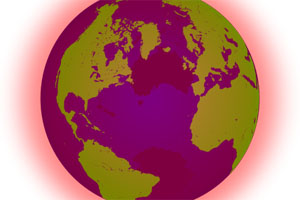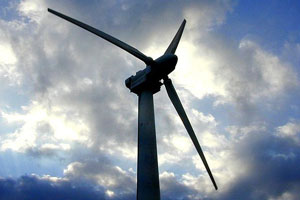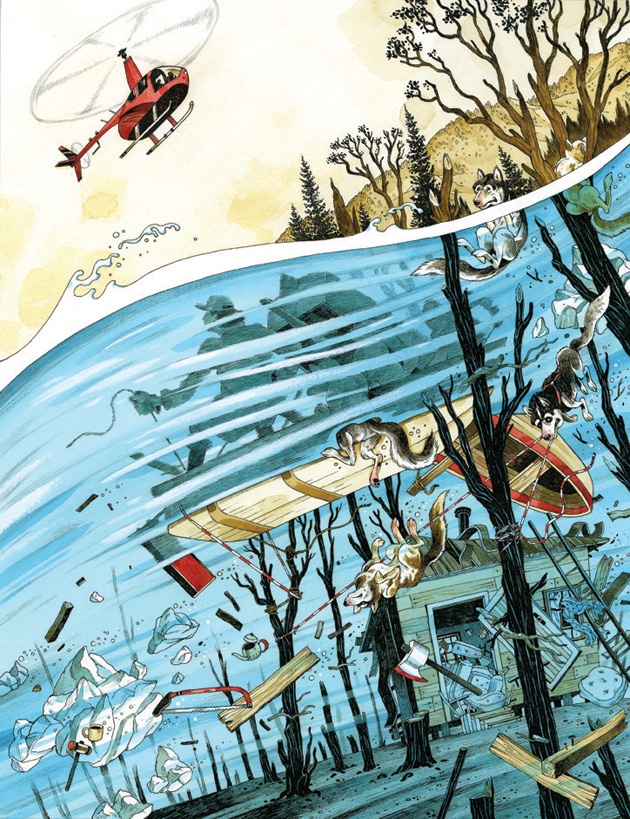
He casteth forth his ice like morsels:
who can stand before his cold?
He sendeth out his word, and melteth them:
he causeth his wind to blow, and the
waters flow. —Psalms 147:17-18
Rick Swisher didn’t see them at first. He’d been dispatched from Fairbanks at a moment’s notice without exact coordinates for the chopper rescue, but any bush pilot worth his salt knows how to find Calico Bluff. Some 20 river miles downstream from the border with Canada, its craggy face has towered over the Yukon River for millennia. Still, floodwaters swelling over the banks and river ice slicing swaths through spruce turned the topography below into an alien landscape. Whole islands were submerged, lakes subsumed. Rick set to circling in search of the cabin where he had been told to expect a couple and their 24 sled dogs. (Before takeoff, his wife, Sharon, had warned, “If you don’t bring back the dogs, don’t you come back either.”) As he banked, Rick spotted the cabin; a man in a bright red shirt balanced on top, waving his arms.
Water surrounded the cabin. With no way for the Robinson R44 Raven II to put down, he planned to attempt a rooftop rescue—but would abort if he observed any hazards. Rick was pleased by what he saw: downed trees sawed off just above water level and floating, a clear path to the corrugated roof. And roped up to the porch beams was a makeshift raft—a canoe and two johnboats, their gunwales lashed together—loaded with sled dogs, tied in and waiting. This pontoon shook and skimmed the whitecaps rippling from the rotor wash, but the dogs sat firm.
Andy Bassich, the man in the red shirt, gestured to the southwest peak of the roof, where a ladder was permanently affixed for cleaning the stovepipe; it would make a ready foothold for stepping into the chopper. Rick lowered, testing the roof—tap, tap, tap—with his landing skid to make certain the structure was sound, then hovered with one skid resting on the roof. Andy called his girlfriend, Kate Rorke, onto the roof as the side door of the chopper swung open. Once safely inside, she pointed out a massive chunk of ice about 75 yards from the cabin. Andy had thought it looked flat enough to land on. Rick hovered over, tapped down, then up, then down again. The ice seemed steady. He lowered a third time and powered down. Andy paddled three dogs out in a canoe and hoisted them onto the ice and then into the helicopter—a trip he would repeat seven more times.
“Make sure they’re in tight,” Rick said, “because if they come up here we’re all dead.” Andy threaded the chopper seatbelts through the dogs’ harnesses. The dogs rode quietly in the back. No yelping or shifting, quiet as they’d been on the water. As the helicopter rounded Eagle Bluff, Rick and Kate could see the airstrip alongside the headquarters of Yukon-Charley Rivers National Preserve and a crowd of people waiting to help unload the dogs. They could also see the wreckage of the town of Eagle stretched along the south bank of the river, the colossal hunks of ice that had floated on the current and leveled dozens of buildings—the hotels and café, the general store, the historic customs house. The Yukon Queen river cruiser pitched and lodged atop the floes, far flung from the boat landing. And everywhere in between, scattered cabins and frame houses lay crushed and splintered open, their contents strewn along the shoreline.
ON MAY 4, 2009, house-size floes carried by the Yukon River formed a giant ice jam 10 miles downriver of Eagle, Alaska. Floodwaters quickly built up behind it. No one in Eagle had ever seen anything like it. The great floods of 1992 and 1937 didn’t hold a candle to this. And Eagle is a town obsessed with its own history.
Spend any time there, and you’ll hear: Jack London entered Alaska this way after the Klondike extinguished his dreams of easy riches; Wyatt Earp, his dreams still burning, floated through en route to the goldfields of the next big strike in Nome; young Lieutenant Billy Mitchell, before becoming a top American flying ace of World War I, was sent to Eagle’s Fort Egbert to complete the telegraph line; famed Arctic explorer Roald Amundsen used that very line to wire the news that he had become the first man to traverse the Northwest Passage. From the beginning, Eagle was the kind of place that drew people seeking to accomplish the impossible, men—and more than a few women—who sought to test themselves against a place that would cut them no breaks, offer no mercy.
Not surprisingly, such colorful characters made Eagle the kind of place that fired writers’ imaginations. The town became an enduring symbol of small-town life in Alaska after John McPhee wrote his classic Coming Into the Country while living in Jim and Elva Scott’s A-frame guest cabin along the river. James Michener was so enthralled by McPhee’s account that he stayed in that same cabin a decade later while researching his epic Alaska. I, too, have published a book about Eagle—a collection of poems called Anna, Washing, an account of the life and death of the town’s first commercial washwoman.
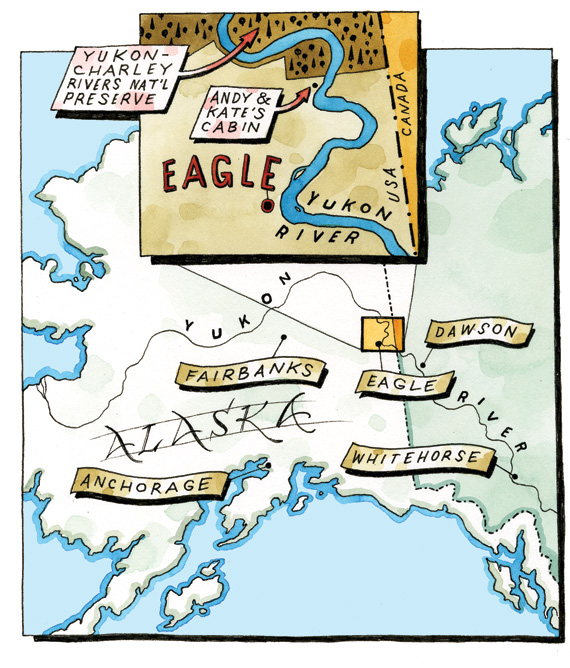
In researching my book, I traveled several times to Eagle. Elva Scott even offered to let me stay in the A-frame cabin—as if writing about Eagle weren’t already daunting enough. After a decade of researching and writing off and on about Eagle, I thought I knew what I needed to know. I thought I was done and could move on. Then, on May 7, I read a tiny item about Sarah Palin pulling out of the White House correspondents’ dinner. She had just declared a state of emergency in Alaska because of record flooding along the Yukon. “It’s basically wiped out a town,” her communications director, Bill McAllister, told CNN. That town turned out to be Eagle. Days later Palin was on the ground to assess the damage, but she told reporters that the “people who live in these remote areas, especially of Alaska, are quite self-sufficient, and they’re not looking necessarily to government to come in and help.”
She was half right. When I pulled into Eagle on May 27, it had been weeks since the floodwaters receded, but the school remained a state-run kitchen for families in need and had been turned into a command center for the alphabet soup of state and federal agencies on hand. To come through, the people of Eagle were not merely going to have to contend with the wreckage of their town; they would also have to navigate a wounded and defensive Federal Emergency Management Agency (FEMA), Alaska’s mission-muddled Division of Homeland Security and Emergency Management, and the touchy politics of needing aid from both Sarah Palin and Barack Obama. Andy Bassich had become the de facto leader of the recovery effort.
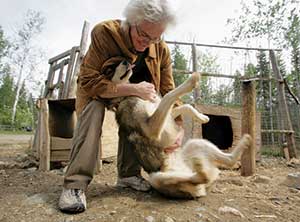 Andy Bassich rubs the belly of his sled dog Vixen. Photo: Sam Harrel
Andy Bassich rubs the belly of his sled dog Vixen. Photo: Sam Harrel
In a town where everyone must improvise from what’s at hand, it is Andy who’s nicknamed MacGyver. He is lean and muscular with unruly shocks of white hair and frameless glasses, a kind of bespectacled Andrew Jackson. He speaks in soft, even tones but always with the ring of authority. When the rest of the community was still shell-shocked by loss, he was sketching out plans for how to build enough winter cabins to house the newly homeless. He had lists of necessary materials, price estimates, schedules.
As we talked, he was constantly interrupted by phone calls from contractors and state officials. He worked with the efficiency and ease of a big-city politician. I would never have guessed that normally, he lived as a relative hermit, with Kate and their sled dogs, miles away from another soul. It’s a solitude they prefer and safeguard—but Andy offered to take me downriver to his cabin, to show me the exact spot where the Yukon they so dearly love had nearly killed them.
BEFORE THERE WAS an Alaska—before the state, its towns, before the territory, even before the tribes—there was the river. The river carried the salmon the people ate, the water they drank. It ran swiftly for travel in the summer and froze firm for easy crossing in the winter. Each spring, when the warming sun returned, the ice broke; it carved cut banks, exposing workable gold, and swept tall spruce and alders downriver to the treeless tundra.
By the 1890s, the river also brought stampeders dreaming of gold—and when there were strikes, it carried faro tables and good-time girls, domestics and missionaries. The river made the towns that made Alaska. Eagle was founded by a ragtag bunch of Klondikers from across the Canadian border in Dawson with names like Old Man Martin and One Thumb Jack. They floated downriver together to a Native village, set up camp near a soaring bluff, and were debating a suitable name when an eagle circled overhead. To attract settlers, they sent three men around the bars of Dawson with the sum wealth of the town in pokes of gold. Each walked in, brandished his poke, bought the house a round of drinks, and told everyone he was on his way back to his claim in Eagle. Within two days, some thousand gold-seekers beset the camp.
The gold rush petered out at the beginning of the 20th century, but Eagle continued to attract a certain breed—what Alaskans would come to call “river people.” In 1937, Ernie Pyle profiled the foremost among them, the sourdough E.A. “Nimrod” Robertson, who, having been rendered toothless by scurvy, “killed a bear, took the bear’s teeth and fashioned a crude plate for himself, then ate the bear with its own teeth.” The point was clear: If you want to survive in Eagle, you have to be as wild as the wilderness.
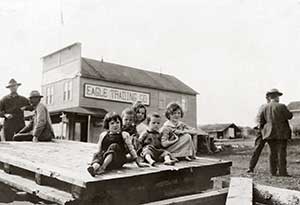 Children in Eagle circa 1900 Photo: Library of Congress
Children in Eagle circa 1900 Photo: Library of Congress
Later, John McPhee valorized Eagle’s residents as the last frontiersmen—people like Dick Cook, whom McPhee dubbed the “acknowledged high swami of the river people.” A classic crank with a streak of anti-governmental paranoia, Cook fought the National Park Service over subsistence restrictions for more than three decades. In fact, in June 2001, Cook was en route from his cabin on the Tatonduk River to protest new restrictions at a meeting in Eagle when his canoe capsized in a rapid chute. His body wasn’t found for days. When I attended the memorial service for him that summer, townspeople wondered openly if Cook had finally tempted the raging waters once too often or, weary of fighting, had simply let the river take him.
Such stories are enough to cow most men. Maybe that’s why the Yukon remains Alaska’s frontier, the unmistakable divide. To this day, along its 1,980-mile route, from Whitehorse in the Yukon Territory all the way to the Bering Sea, only four bridges span the river. The great empty Alaskan wilderness to the north encompasses nearly 300,000 square miles—roughly the landmass of Texas—but barely 20,000 people live there. Why would you? During the winter, the sun disappears. Temperatures have plummeted to 80 below. The only food is whatever you’ve flown in or stockpiled or can trap or hunt. Even during the long days of summer, all is preparation, a constant buffeting against winter’s return. Life so close to death attracts a certain breed. Seekers of nature’s terminal limit, the Ultima Thule of rugged individualism. Men like Nimrod Robertson and Dick Cook, men like Andy Bassich.
Yet for all its severity, the Yukon is a fragile frontier. The human footprint on Alaska’s ice fields and tundra and boreal forests is significant—and growing. A greater menace still is the world community of fossil fuel consumers, mostly Americans, whose appetite is fed by Alaskan oil, drilled offshore in the Arctic and transported across the tundra via the pipeline. That oil is the lifeblood of Alaska. It is also, it now seems, a principal threat to their way of life—and every Alaskan has been made complicit.
In 2008, each citizen was allotted $3,269 in payouts from state-invested funds ceded by oil interests—via the Alaska Permanent Fund Dividend and the Alaska Resource Rebate. Even households in the remotest areas, places where people think of themselves as outside state rule, receive state assistance and pay into an economy built on the very industry that is destroying the natural world they love and depend upon. For a generation, Alaskans have argued that their numbers are too small, the wilderness too wide for their drilling to have a lasting effect. But the real threat comes from the people they supply, people who may never see Alaska but whose carbon emissions are wreaking havoc at the poles. The May flooding was a mere foretaste of the destruction that global climate change could bring to the Upper Yukon.
Canada’s Yukon Department of Environment has noted that spring breakups on the Yukon near Dawson, more than a hundred miles upriver but south of Eagle, trended a full six days earlier by the end of the 20th century—and other studies show fall freeze-ups trending equally late. Two weeks may not seem like much, but the effects are dramatic. Warmer fall and winter temperatures cause the river ice to freeze and thaw sometimes several times before final freeze-up; this produces “jumbled ice” as one layer piles on top of another. Around Eagle, Andy saw exactly this. “The river stopped at freeze-up time,” he told me, “and then it broke, and it moved. It was like a minibreakup.” It produced such rough ice that Andy and his neighbors couldn’t use the river to travel this winter; they had to cut new overland trails.
The additional weeks of runoff have also noticeably raised the water level of the river. In 2007, Christopher Milly, a research hydrologist at the US Geological Survey, testified at a Senate hearing on the impact of climate change that a recent reading of the “flow of the Yukon River at Eagle, Alaska, was 3 percent higher than during the preceding 26 years…possibly related to warming-induced changes in snowfall and snowmelt.” The elevated water level means that ice forms higher on the banks of the river. Under normal conditions, dirt and pebbles from the banks blow into the river during freeze-up and harden into the surface ice. The dark coating absorbs the sun’s heat and thaws the ice more evenly and gradually. In 2008, Andy told me, Eagle “didn’t have silt blowing around like we normally do. Because the river froze so high, the normal cut banks that are exposed where the silt would blow around and coat the ice, that didn’t happen. So when the sun came out, it was reflecting off the snow, rather than hitting that dark silt.”
On top of all that, Alaska as a whole experienced an unusually wet winter that dropped heavy snowfall in the mountains. In April, just three weeks before this year’s breakup, federal hydrologist Larry Rundquist warned that scientific models were showing that a global warming trend could cause increased mountain snow to melt early and flood the rivers below. With the thick ice acting as a dam, the runoff would have nowhere to go but the surrounding valleys. Then, at the end of April, already unseasonably warm weather turned record breaking—setting new marks for four of five days between April 29 and May 3. In Fairbanks, the National Weather Service recorded temperatures 10 to 15 degrees above normal for a week.
It was even hotter near Eagle. “We had temperatures close to 80 one day,” said Andy. “The mountains were clearing their snow really quick; that was pouring into the feeder streams of the Yukon.” On April 29, the day the heat wave began, Andy went out to the river for water, set up an augur on an extension, and sent the bit spiraling five feet deep: nothing but ice. So he took a long pole with a chisel on one end and chipped away until he finally broke through to the river water below.
“This is going to be an interesting breakup,” Andy thought. He went back to his property and started dragging everything away from the river’s edge.
IT WAS ABOUT 8 p.m. on Monday, May 4, when Andy and Kate went down to the river to watch the ice start to move. After the long winter, breakup is treated like a holiday. When they arrived at the banks, they found the lower level of their property flooded. “When the ice comes in, it comes in in stages,” Andy explained. “It’ll come in and flood; then it recedes. Then it comes in higher; then it recedes.” They were watching the river surge and ebb when, suddenly, water started pouring in from behind them. Andy realized that the Yukon had breached its banks and merged with Ford Lake behind their property. They were an island now, and the river was still rising. Andy and Kate watched as their picnic table floated away, then the salmon-egg-drying rack. And the water was coming in faster.
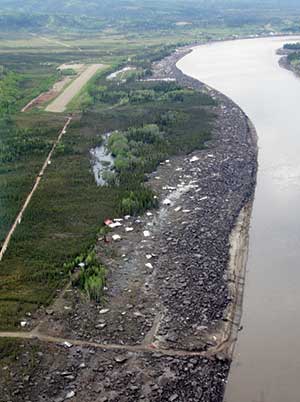 The Yukon flung the buildings of Eagle and the nearby Native village inland.Photo: Sam Harrel
The Yukon flung the buildings of Eagle and the nearby Native village inland.Photo: Sam Harrel
Andy went out to his 12-foot johnboat and two canoes; he cut a few short spruces to serve as crossbeams, then lashed the boats together into a makeshift pontoon. They don’t call him MacGyver for nothing. He called Kate to bring in the 18-foot flat-bottom johnboat and tie it off as he began unchaining his sled dogs. The surging water was now nearly waist-deep. Eight of the dogs made it to the cabin porch on their own; Andy loaded another eight in the boats. Nine others had been carried away by the current—missing and possibly dead. Through the trees, Andy could see one dog perched on blocks of blue Styrofoam insulation; another balanced on top of the barbecue grill until the current lifted and toppled it.
He waded over to the larger johnboat, tied it together with a canoe for stability, strung it behind the pontoon, then roped everything to a corner post of his pole shed. The water was bone-chilling, barely above freezing. It was pushing toward 10 o’clock, and the sun was starting to set. Andy’s hip-waders were heavy and cold, but he felt a small sense of accomplishment knowing he had enough boats together to hold all the dogs, if he could just find them.
After sunset, the surge subsided, the missing dogs returned, and Andy was able to get into his shed. He gathered a length of half-inch rope and a long pole he had prepared days earlier. He tied the rope to the corner post of the shed and canoed across to the cabin and tied off the other end of the rope to one of the porch beams. He made his way back to the other boats, then pulled the whole flotilla, hand over hand, to the cabin.
The water level was now up to the floor of the elevated porch and still rising. Inside, Kate gathered sleeping bags, extra coats and socks. Even as they hurried everything together, water was starting to bubble up from the root cellar. It rattled the cellar door and finally blew the hinges off, sending water rushing knee-deep into the cabin. They pushed outside, water pouring in as if the house were a sinking ship. Andy pulled the dogs from the porch into the long johnboat and clipped them in. They would hunker low in the hull and ride this one out.
All night, they sat vigil in the boats—marking the level of the floodwaters by the light of their headlamps, watching as the surges finally rose above the knob of the cabin door. They watched as the sauna lifted and floated across the clearing, as their guest cabins bobbed away on the river ice, as Andy’s toolshed pitched and jounced. They sat as the temperature dropped below freezing. After several hours, the sun started to peek out in the east. “Finally,” Andy thought. “Finally, some daylight. Maybe some warmth.” Suddenly, the current started picking up—rushing faster and faster, but this time in toward the river. Something had broken loose, and now all the dammed-up water was going out like water draining from a bathtub.
“It was like being in a Class 3 or Class 4 rapids,” Andy said. “There were standing waves. Everything was just ripping by us—barrels of fuel, all our belongings. Our shed lifted up and pinned itself against the cabin.” The current was rushing so fast that the canoes were vibrating, and the long johnboat started hydroplaning despite the weight of 14 dogs. Suddenly, Andy realized what was happening: The water level was dropping so rapidly that the tie lines were binding, lifting the boats’ bows, and threatening to capsize them. He leaped onto the porch and tried to work the rope down the square timber beam, but the line was taut and bit into the grain. He didn’t dare cut it—for fear Kate and the dogs would be swept away—so he stepped into the bow of the largest boat to try to leverage from below, but the nervous dogs shifted, and the whole johnboat flipped on its side.
Half the dogs were sucked into the current but, still tied in, were held underwater, drowning. The other half clung to the gunwale by their teeth, shrieking through clenched jaws. “The thing I will never forget is the screaming of the dogs,” Andy told me. He straddled between the porch and another canoe, pulled a knife from his pocket, and started fishing dogs from the current, cutting their lines and heaving them—most 80 pounds and soaking wet—onto the porch. Then he cut loose the dogs still hanging by their teeth and tossed them to safety too. A canoe broke loose of its lashing, so Andy leaped back and cut it free before it could capsize Kate’s johnboat. The current swept it away and wrapped it around a tree. Then another canoe, holding five dogs, broke loose; three jumped into Kate’s boat as they rushed by. The other two, Iceberg and Ouzo, jumped and swam hard against the current but were sucked away and disappeared into the woods. “They’re gone,” Andy said, and Kate started to cry.
Another 45 minutes passed as their yard emptied. When the current finally slowed, Kate’s boat began to wobble—”like it was on the head of a pin,” she told me later. Andy thought a log had lodged underneath, but when he reached down to clear the obstruction he found it was the body of one of the dogs, Skipper. “He was the last dog at the back of the boat,” Andy remembered, “and when he got sucked under, I just never saw him.”
Eventually, the water receded enough that Kate and Andy could see ground; the dogs jumped from the boat and frolicked as the last of the current trickled out. Andy started calling them to the dog picket line, each by name. “Remington, Donner, Snickers, Control,” and on down the list. Then, by habit, “Iceberg, Ouzo,” and the two lost dogs came bounding from the woods. Andy shouted for joy. All the dogs but Skipper had survived. “At that point, we thought, ‘Okay, we’ve made it.'”
Kate went to call Eagle on the marine band radio while Andy relashed the remaining boats. With the town already decimated, no one answered her call. But Wayne and Scarlett Hall, their upriver neighbors, picked up Kate’s signal and called the Park Service on their satellite phone. Andy had just roped the boats off when Kate called out: More water and ice were coming.
Andy worried that the woods protecting his property might not withstand a second wave of ice floes. He led the dogs, two by two, to the pontoon and clipped them back in. By the time he loaded the last of them, the water was up to the porch floor again. He got back on the radio to see if the Halls could call out to the Park Service for a helicopter. “It’ll have to be off the roof,” Andy told them. Soon Scarlett radioed back that all trees above roof level within a 50-foot radius of the cabin would have to be cleared. Andy waded into the icy waters and set to work.
As he remembered, he walked me around the property, pointing out the relics of his story. Here was the aluminum canoe folded and cracked where it had wrapped around a tree. Here the long johnboat, with the loops he had tied for the dogs and later cut. All the outbuildings clustered, pushed by the furious onrush of the river. The grass still laid flat, the turf in places rolled up like a rug. The square post of the cabin porch, scarred where a rope had bitten hard into the grain.
Last, Andy took me behind the cabin. All the trees had been sawed into chest-high stumps—by my count, more than 30, most about five inches in diameter. I marveled at the precision of it. “You did this in an hour?” I asked. “Are you sure?” Andy smiled broadly. He walked over to a makeshift toolshed where his bright orange bow saw—what Andy calls a Swede saw—hung on a peg. He took the saw in hand.
“You can cut a lot of trees when you have to,” Andy said.
AS DRAMATIC as Andy and Kate’s story of survival may sound, it is hardly unique. In my days in Eagle, I met Mark Malcolm, who literally outran the rising floodwaters in a furious footrace to higher ground; Slana Waller, who smoked one last cigarette looking out her garage before fleeing; Don Mann, whose family was in the midst of making a raft from the interior doors of their house when they were rescued by canoe. Story after story of near death, averted by ingenuity and collective effort.
But in the weeks and months that followed, the maze of government assistance and insurance paperwork grew. Marlys and Charlie House were informed by Great Lakes Reinsurance that the damage to their bed-and-breakfast would not be covered, because it was found to be the result of water, not ice. FEMA topped out funds for each family whose home had been destroyed at $30,300—and Christian relief organization Samaritan’s Purse chipped in another $10,000. That money goes fast, and initially half of the displaced families chose not to overwinter in Eagle this year. Andy’s efforts have reduced that number, but Eagle’s survival is not yet assured.
I sat next to Andy behind the windscreen of his johnboat as he steered us back upriver toward Eagle. The sun was finally sinking toward the mountains, and on both banks chunks of ice split and calved, sizzling and rolling in the current. Andy was quiet; this day’s tasks almost complete, I could practically see him making his list for tomorrow.
“Do you ever think of leaving?” I barked over the roar of the outboard.
“No,” Andy said, his eyes never leaving the rippling surface. “This is where I belong.”
He was mushing down the Yukon in March 1984, he explained, when he first followed an overland trail toward Ford Lake and glimpsed the place he now owns. He had stopped to give the dogs a rest there when he was overwhelmed by a powerful feeling of déjà vu. “It’s not something I can really describe,” he told me. “I just felt that I had lived there before.” He spent the next nine years working to buy the land, another ten clearing the property and building his cabin and sheds. He couldn’t just leave now. And yet, he—and everyone else living along the Upper Yukon—may soon have to examine the viability of continued existence there. Their way of life will survive another winter, but who knows what the next spring breakup will bring?
When I posed this question to Larry Rundquist at the National Weather Service, he was reluctant to predict. “Was this record warm spell a temporary weather anomaly in 2009,” he responded, “or is it an example of weather patterns that can be expected with either a cold PDO [Pacific Decadal Oscillation] or global warming? I do not have an answer to that.” Only time will tell, but if the trend should continue it will mark a turning point in American expansionism. Since the westward expedition of Lewis and Clark, our nation’s history—and identity—has been wrapped up in our ever widening reach. We steadily tamed new frontiers and bent them to our needs. Should the Upper Yukon turn uninhabitable, the frontier, for the first time in American history, will push back, reclaiming for a wounded wilderness what previously had belonged to man.
Andy’s outboard buzzed.
“What will you do if the river floods next spring?” I asked. “You can’t do this every year.”
“Do you know who Dick Cook was?” Andy asked, and for the first time, he fixed me with his gaze. I nodded. Of course, McPhee’s high swami of the river people who capsized and drowned in a rapid. “That’s how I want to go,” Andy said. “I don’t want to waste away in some nursing home in Fairbanks. If I’m ever diagnosed with a terminal disease, I plan to build myself a raft and just float downriver. When my time comes, I hope the river takes me.”
I stared out at the rippling current, the water rolling gently toward us but swiftly, carrying downed trees and other debris, the melting ice still releasing its wreckage into the river.
“It almost took you this time,” I said.
Andy smiled. “Almost,” he said.
